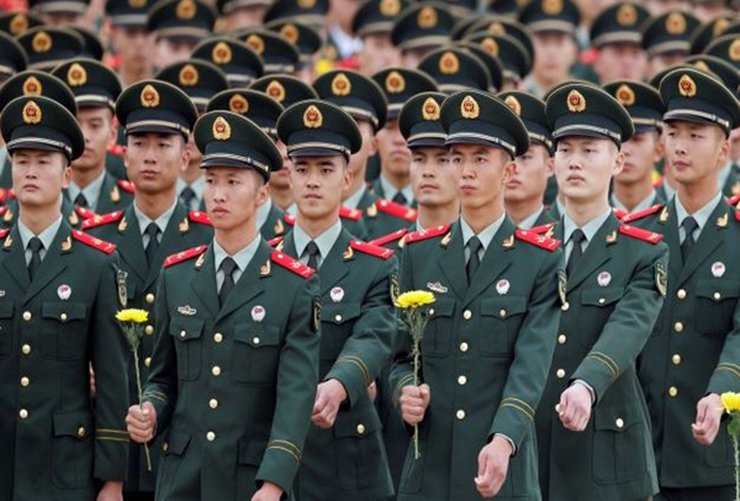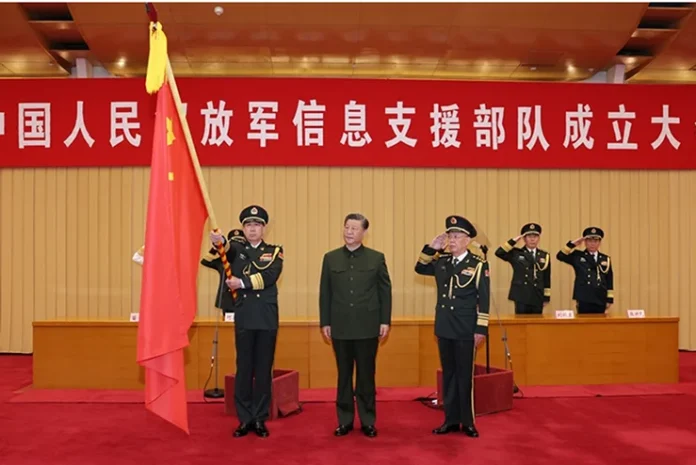The Chinese People’s Liberation Army (PLA) now has launched a new system of information warfare, called the Information Support Force (ISF), said Wu Qian, spokesman for the Ministry of National Defence, on Friday 12 April 2024. Chinese President Xi Jinping presented a flag at an establishment ceremony for the new military arm held in Beijing.
Xi, also general secretary of the Communist Party of China Central Committee and chairman of the Central Military Commission, stressed on solid efforts to build a strong and modernised Information Support Force.
Speaking at a press conference in Beijing, Wu outlined the updated structure of the Chinese defence forces. “With the latest reform, the PLA now has a new system of services and arms under the leadership and command of the Central Military Commission. There are four services, namely the Army, the Navy, the Air Force and the Rocket Force, and four arms, including the Aerospace Force, the Cyberspace Force, the Information Support Force and the Joint Logistic Support Force. As circumstances and tasks evolve, we will continue to refine the military force structure with Chinese characteristics,” said the spokesman.
The shift of information warfare to the direct command of the Central Military Commission – the top Communist party and state organ that controls the People’s Liberation Army – would hand Chinese leader Xi Jinping even more direct control over the military.
The ISF will aim to “speed up military modernisation and effectively implement the mission of the people’s armed forces in the new era”, Xi said at the Beijing ceremony.
The new arm will be removed from the Strategic Support Force, which was set up eight years ago combining information, cyber and space warfare departments under Xi’s previous military restructuring
The new arm will be removed from the Strategic Support Force (SSF), which was set up eight years ago as a new PLA branch combining information, cyber and space warfare departments under Xi’s previous military restructuring, according to a statement from the PLA Daily military news service.
The space and cyber forces would also be brought under a new command structure, it said, de facto abolishing the SSF. Under the SSF, the information forces were in charge of collecting technical intelligence and providing intelligence support to the regional military chiefs.
Bi Yi, a veteran army general, was appointed commander of the new ISF, and Li Wei named as its political commissar. The latter position wields power equivalent to a military commander, as the Communist Party seeks to enforce absolute loyalty and ideological correctness in the Chinese armed forces.
Beijing’s efforts to further strengthen the PLA are closely watched as China challenges US dominance in the Indo-Pacific region and wields its growing military power to intimidate various neighbours in territorial disputes.
Xi’s last major PLA restructuring in 2015 moved key functions such as logistics, training and mobilisation directly under the command of the CMC, which he chairs.
Beijing’s efforts to further strengthen the PLA are closely watched as China challenges US dominance in the Indo-Pacific region and wields its growing military power to intimidate various neighbours in territorial disputes
At that time combining cyber, information and space forces under the SSF was viewed as an attempt to create a similar direct control system.
But experts on the Chinese military said that leaders had unwound that structure as a result of an incident last year in which a Chinese surveillance balloon was shot down by the US, as well as corruption investigations into generals’ misdoings and a failure to achieve synergies across the different divisions within the SSF.
The military leadership has been experimenting with smaller reorganisations in recent years, suggesting that the 2015 reforms were not complete.
Xi urged the force to integrate deeply into the Chinese military’s joint operation system, carry out information support operations in a precise and effective manner, and facilitate military operations in various directions and fields. He ordered the force to resolutely obey the ruling Communist Party’s command, and make sure it stays absolutely loyal, pure and reliable.
Since he assumed power in 2012, Xi has revamped the military, reducing its size to around two million besides overhauling the command structures of the PLA and creating a missile force called the Rocket Force
He also urged efforts to build a network information system that fulfils the requirements of modern warfare and features the Chinese military’s own characteristics, as well as efforts to accelerate the development of integrated combat capabilities more effectively.
Since he assumed power in 2012, Xi has revamped the military, reducing its size to around two million by retrenching three lakh troops and officers besides overhauling the command structures of the PLA and creating a missile force called the Rocket Force. He also introduced the system of constant training of troops with real wartime exercises.

The previous commander of the SSF was Ju Qiansheng, whose disappearance had spurred speculation of being linked to the broader turmoil in China’s military leadership that’s unfolded over the past year. While Ju has recently resurfaced, state media hasn’t made clear his current position.
The restructuring comes as the world’s second-largest economy faces off with the US in a fight for global dominance, with cyber warfare emerging as a key battleground.
The US, UK and New Zealand accused China last month of sponsoring malicious cyber activity in targeting democratic institutions.
India needs to up its game a little bit more and adopt a more robust and changing dynamically with times strategy to establish a lead over China’s cyber capabilities
The latest revamp follows a sweeping purge by Xi of the military establishment last year. US intelligence experts viewed that move as a response to the discovery of widespread corruption in the military, including in the Rocket Force, which manages the country’s expanding nuclear arsenal.
For India, the latest Chinese move should come as a reckoning to further bolster its efforts in AI and cyber capacities. Apart from the defence sector, some countries including India have various social media apps owned and operated by Chinese companies, in addition to the threat posed by Chinese hackers.
In the given scenario it would be better for India to err in caution rather than being caught unaware, after China further consolidates its cyber capacities in the defence sector. India needs to up its game a little bit more and adopt a more robust and changing dynamically with times strategy to establish a lead over China’s cyber capabilities.
–The writer is a political commentator based in New Delhi. He can be contacted on www.asadmirza.in. The views expressed are of the writer and do not necessarily reflect the views of Raksha Anirveda
-The writer is a New Delhi-based senior commentator on international and strategic affairs, environmental issues, an interfaith practitioner, and a media consultant. The views expressed are personal and do not necessarily carry the views of Raksha Anirveda






